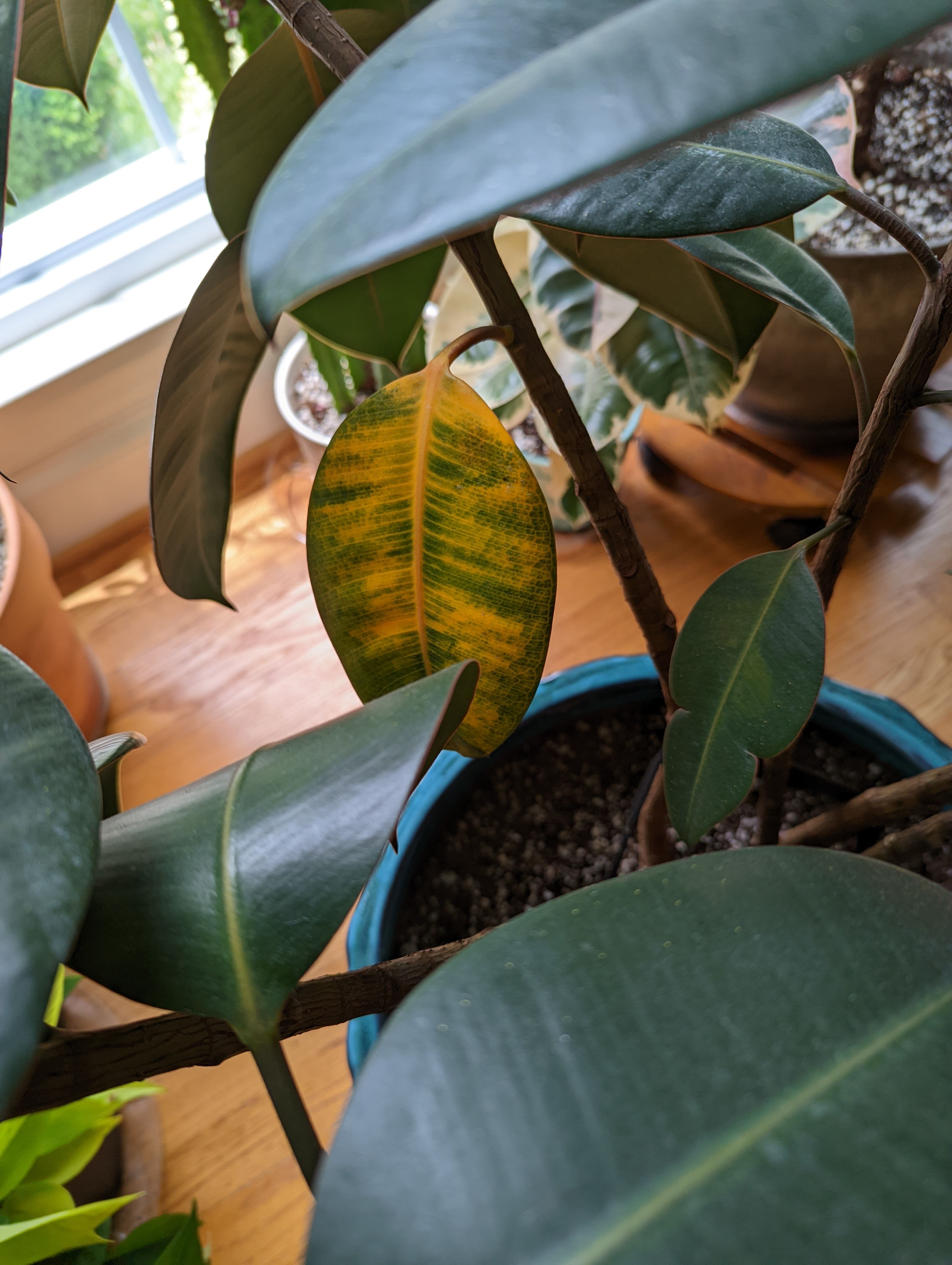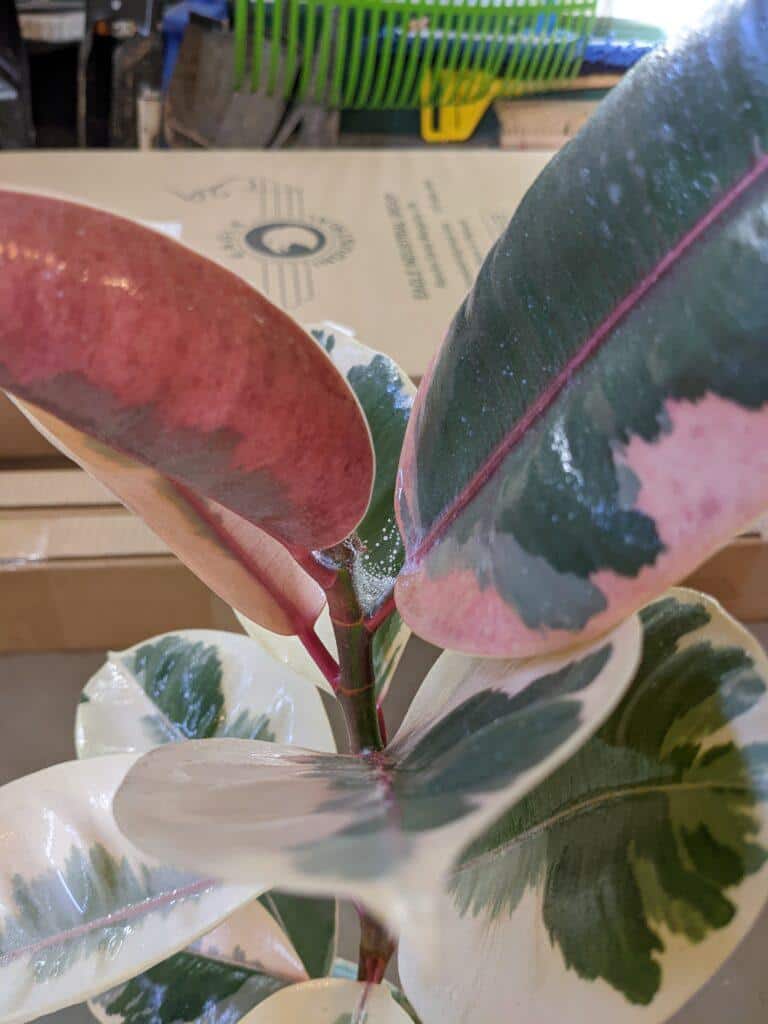Rubber Plant Leaves Turning Yellow
Once or twice a year my Rubber Plant gets a yellow leaf or two. Yellow leaves can be no big deal at all or it may be your plant telling you that you need to intervene. This post will cover some scenarios in which you might encounter yellow leaves and how to address them if need be.
What Causes Rubber Plant Leaves Turning Yellow?
Water Issues Can Cause Yellow Leaves
Underwatering and over-watering can cause Rubber Plants to have yellow leaves. For me, the most reliable way to tell if there are water issues is to use a soil moisture meter. Something simple like this soil moisture meter will do the trick. If you don't have a moisture meter you can also use your finger.
I typically err on the side of keeping my houseplants on the dry side. For some plants it's really easy to tell when they need water because they droop, but Rubber Plants don't really droop, at least not quickly. If you are underwatering, typically the leaves that turn yellow first are the oldest ones closest to the base of a stem. These are the older leaves and tend to be more susceptible to drying out. You can see an example in the photo below.

Conversely, if your soil feels moist and the yellow leaves are more disbursed and not concentrated at the base of the stems, then you may be dealing with overwatering.
How to Fix Water Issues
If you are underwatering, it's pretty straightforward. Water your plant. I want to say for clarity though that just because a lower leaf turns yellow, does not automatically mean your plant is underwatered. In fact, it can be completely normal for a single older leaf to eventually yellow and fall off.
If you do think you are underwatering though, just don't go too far in the other direction. Also, unfortunately, the leaves that are already yellow will not regain their color. You can let them fall off or pull them off if you want to. When you do start watering more, make sure that the water doesn't just run through your plant because it was previously underwatered. If that happens, you may need to water from the bottom. Watering from the bottom just means sticking your plant pot in a bowl or the sink with water and the soil and roots soak up water from the base of the plant.
If you have overwatered, the intervention is more complicated. The first thing you want to do is carefully remove your Rubber Plant from its pot. That will let the root ball and soil dry out more quickly. Overwatered roots are very tender and vulnerable, so you must be careful and clean. Once the root ball has dried enough to handle, inspect the roots for rot. Rotten roots will be brown and feel mushy. If you find rotten roots you need to cut them away with something clean and sharp. Then you can repot your Rubber Plant in new soil and hope for the best. I have a whole post dedicated to fixing an overwatered plant if you want to follow along in more detail.
Fertilizing Issues Can Yellow Leaves
Nutrients are the same as water you can both over and under-fertilize. Yellow leaves are generally a sign of under-fertilization. Plants that have been overfertilized are more likely to exhibit slow growth and maybe wilting. Typical houseplant fertilizers have a balanced ratio of nitrogen, phosphorous, and potassium, or n-p-k, which you see on the label of the plant fertilizer. Yellow leaves may be a symptom of a lack of nitrogen or potassium. Nitrogen helps promote healthy foliage growth and potassium is for overall plant health.
Fertilization issues may affect the lowest leaves first but you'll often see signs in a lot of leaves. Other signs that you have a fertilization issue can be slow growth. Rubber Plants aren't the fastest growers anyway, so it can be hard to really tell if it's growing slowly. I use soil rapitest which allows you to test for ph and each nutrient individually. It's the only way to be totally sure you have a nutrient deficiency or abundance. If you have a lot of plants, it's a good investment.
How to Fix Fertilization Issues
If you have overfertilized your Rubber Plant, your best bet is to flush the soil by watering it a lot. You may even want to remove the plant from its pot. That will let the water flush freely and also let the soil dry out faster because you don't want to end up overwatering either.
To fix an under-fertilized plant you will need to fertilize it. Water-soluble or liquid fertilizers work best for quicker absorption. If you don't opt for a soil rapitest that I talked about earlier, then you're best off sticking with a balanced fertilizer that has the same number in the n-p-k ratio. However, if you know for sure you have either nitrogen or potassium deficiency, then you can find fertilizers that have higher ratios of the nutrient you need. Be sure to follow the instructions on the fertilizing product. Some fertilizers require dilution or that you water the plant beforehand.
Pests Can Cause Yellow Leaves
Unfortunately, a wide variety of pests can attack indoor plants. The big ones that attack foliage, causing leaf yellowing, are aphids, scale/mealybugs, spider mites, and thrips. These pests pierce your leaves to feed and ultimately destroy the plant's leaves. Yellowing from pest damage is typically spotty where the pests have attacked. If you think you might have pests, do a close visual inspection of your plant asap. Use a flashlight to help you see contrast and shadows. Pay close attention to the underside of the leaves and where new leaves are growing.

How to Fix Pest Issues
If you have pests, it is very important that you move the infested plant away from other healthy plants as soon as possible. Pests are so good at traveling to seek and destroy new plants! Next, you'll need a multipronged approach to address the pests. First, you must remove as many as possible. A strong spray can remove most pests. You can do so in the shower or outside with a hose. Scale and mealybugs require manual removal because they have an armor-like shell.
Next use an insecticide. There are organic versions like neem oil that do well. I have personally used neem oil on spider mites that had infested one of my Rubber Plants successfully. Nonorganic insecticidal soap also works on these pests. The final and most critical step is to repeat removal and insecticide application until you do not see any pests for over a week. The reason is that pests have short lifecycles, so although you don't see them, their eggs may still remain.
Hopefully, this helps explain why your Rubber Plant had yellow leaves and now you can begin your journey to fix it. Have any questions? Post them in the Comments section below.
Add new comment